|
Tefillin in Detail The sofer uses a turkey feather or reed as a quill. The sofer's quill is called a kulmus in Hebrew. The reed is commonly used by Sephardi sofrim. It is said that the kulmus should be nice looking as this is an expression of endearment for the holy task. The making of the kulmus is of great importance. It is an acquired skill to create a perfect quill that will create sharp, fine lines, bold, flat strokes and clean, rounded corners. The success of a sofer is partially dependant on being able to make a proper quill. An expert sofer will know how to press the quill onto the parchment with limited pressure. This will enable the sofer to use the quill longer without the need of a trim.
Ink in Hebrew is Diyoh. Unlike in yesteryear when each sofer produced his own ink, some of it being better than others, today the sofer purchases ink at a store that carries safrus supplies. There are perhaps a dozen ink makers. The sofer chooses his ink of preference. In the winter the ink may be runny so he would leave the cap off to let it thicken a bit while in the summer he may add water or other chemicals, as directed by the ink maker. Over watering will make the ink grayish and may affect the halachic status of the writing and will surely cause the ink to fade more quickly to an unacceptable shade.
The parchment is called klaf. It is made from the hide of a kosher animal species. There are 3 layers of the hide. The top layer just below the hair is called gvil. The layer beneath is called klaf and the lowest layer, against the flesh, is called duchsustus. Torahs may be written on gvil or klaf. Tefillin and mezuzahs are written exclusively on klaf. The use of gvil today is very uncommon. Today, most klaf is shelil, embryo, made from the hides of calves. It makes the finest klaf.
The tanning process must
be done lishma, with specific intention for the holiness of Torah, tefillin
and mezuzah. This is done by an observant, male Jew. He does this by expressing,
"Lshem kedushas sefer Torah, tefillin u'mezuzah" at the outset
of the tanning process. Please note that this is a very basic introduction.
There are a number of halachic factors and opinions, which have not been
mentioned. In order to write on the klaf, straight lines, sirtut (seertoot), must be manually scored with an awl along where the letters will be written. In addition lines are scored along the right and left margins. Some sofrim write on klaf mashuach, coated parchment. This is a thin coating of white limewash along the top surface. Its purpose is to allow the sofer to write more quickly. Such mezuzahs, for example, are less expensive since they can be written faster and more easily. The quality of the writing is often sloppy and the fact they feel the need to write a mezuzah in ¼ the time is a poor reflection of their sincerity for the halachah and their holy task.
The majority of halachic authorities do permit this coating from a pure halachic perspective. However, they are adamantly against it and often forbid its use because the coating has tendency to crack causing the letters to crack, invalidating that which is written on it. Some older Torahs have a coating on the backside. This was done to beautify the parchment and likely to cover up various blemishes. This adds significant weight to the Torah scroll and leaves residue on the letters, giving them a false gray appearance. There is no halachic concern other than the coating concealing patches. Parts of letters may not be written on a patch.
Lishma means "for the sake of x". Prior to beginning to write a Torah the sofer must pronounce "L'shem kedushas sefer Torah", ("I am writing this Torah) for the sake of the sanctification of the Torah scroll". The same is true for tefillin, mezuzah, megillah and the prophets. There is discussion as to the most precise and preferred pronouncement. If this was not done the Torah scroll, for example is invalid! In addition, upon writing each of the unerasable names of G-d, the sofer must express, "L'shem kedushas Hashem", "for the sake of the sanctification of G-d's name". Once again, if this was neglected, the Torah is invalid. It becomes crystal clear that the integrity of the sofer plays a major role. The beauty of the writing and its halachic precision are very important, however, to make certain that the sofer's integrity is above reproach is as important and even of greater importance. To know the sofer or to acquire from a source that knows the sofer and is an impeccable source is of utmost importance! Chok Tochos translates as "scratching within". A letter must be formed only by writing. Scratching away ink from a blob to form a letter is invalid. Similarly, a letter that never had its form or has lost its form and is therefore invalid, such as two letters that become connected and now appear as one different letter, cannot be repaired by simply severing the connection to return them to their original forms. The letters must be erased and rewritten. Shelo Kesidran means "not in sequence". Each letter in tefillin and mezuzah must be written in their chronological sequence. One must start and complete each letter, one by one. Therefore, if a letter was found missing or not written correctly or even became invalid at a later date there would not be any way for it to be repaired. This halachah does not apply in a Torah scroll, megillah or the prophets so later sections can be written first. The letters of G-d's Holy names also must be written in order but can be repaired out of sequence when necessary. Mukaf Gvil translates to "surrounded by parchment". Halachah requires that each letter's integrity is not violated by another letter touching it, the letter touching a hole in the parchment nor touching the edges of the parchment. The laws are complex and each situation and the manner of repair cannot be presented in detail. Suffice to say that in general two touching letters are invalid however, they can be separated if their forms have not been altered or lost due to the connection. Similarly, a letter that has touched a hole or the edge can generally be repaired. Shailos chacham is
a query for aposek, halachic authority. Often there will be letters whose
form comes into question orthe sofer may have done Shailos tinok is
a query presented to a child. Occasionally a posek will be in doubt how
to render a decision, psak. He will feel that there are positions in halachah
to consider a letter both kosher and passul. He will suggest that a child,
Some opinions
require the gid to be made lishma, for the sake of the holiness of tefillin,
which can Before the tefillin are sewn, each of the 4, folded head tefillin parchments and the single, rolled arm tefillin parchment are wrapped with sa'aros, hairs from the tail ofa cow. They are then tied with a single piece of plain parchment and again sa'aros are tied around them.
Cow's Tail
There are four types of batim. Peshutim: Peshutim means simple. These batim are made from a number of pieces of parchment, which are glued together. They are generally poor quality, often are halachically problematic and will likely not last many years. Peshutim Mehudarim: The upper section of these batim are made from onepiece of parchment which is cut in a manner so that they can be folded and glued to create solid boxes, like origami. Additional pieces may be added to strengthen them. The batim are then set into a base of hide. These batim are not halachically preferable according to many authorities even though the upper section is one solid piece, which is preferred by halachah. These authorities require that the upper sections be one solid piece of leather without the need for glue. Due to their light weight and thin walls they tend to have a shorter life span than dakos or gasos. The advantage over dakos is that the layer of paint is much thinner so certain halachic problems would be visible while the thick layer of paint can conceal these problems. Dakos: These are made from a thin skinned animal such as a goat. The single piece of thin hide is stretched over and glued to an upper frame of thicker hide in the shape of a square and a lower frame, which serves asthe base. By doing so, both the upper and lower sections are consiidered to be made from one solid piece of hide. They are reasonably sturdy. They are not very aesthetically pleasing and not as halachically preferable as gasos batim. These were the best type of batim available until the early 20th century. Since gasos are now available, are far superior and are quite reasonable therefore, dakos are no longer invested with the same precision and concern for quality and exactness. Gasos: These are made from one solid piece of hide, from the face and neck, from a thick skinned animal such as a bull. Great expertise, time, effort and precision are required. On the one hand they require delicate handiwork while on the other hand they are pressed with many tons of pressure. They take weeks, if not months, to make as they need to dry properly in between each stage, preferably through the summer and winter seasons,so they will permanently retain their form. They are far superior aesthetically, halachically and qualitatively. They last many years and can be repaired and refinished as new. It is worth every effort to acquire gasos! Those who definitely cannot afford gasos should buy dakos or peshutim mehudarim. (Not to be confused with peshutim.) At STAM we only carry high quality gasos and peshutim mehudarim!
Retzuos are the black, leather
straps that are drawn through the back passageway of the batim to bind
them on the head and arm. They are knotted in a special manner. There
are a few customs as how the retzuos are knotted and wrapped on the arm.
They are made from the hides of a bull or cow. The leather is tanned similar
to the way leather for purses and shoes are tanned. The difference is
that the procedure for tanning retzuos (and batim and parchment) is strictly
regulated by halachah. The completed and painted hides are hand cut into
straps by a Torah observant male who expresses that he is doing so for
the sake of the holiness of tefillin. The hides can be tanned by hand or machine. In order not to enter into any halachic dilemmas hand made retzuos are recommended. They are more expensive but well worth it. The only retzuos made under independent rabbinical supervision are hand made. This is another reason to only use them. We only use hand made, elyon retzuos, even on our more economically priced tefillin in order to ensure you quality, long lasting and undoubtedly kosher retzuos!
|
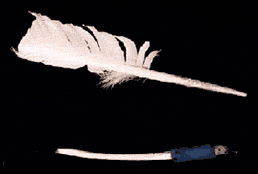 Sofer's Quill
Sofer's Quill
 from the gallnut and Ferrous sulfate or copper sulfate. These two chemicals
cause the ink to turn black. The ink must be pitch black. Over the years
the ink may turn a reddish or rusty color. This is because of the Copper
sulfate. If this happens after many years then many halachic authorities
consider it kosher.
from the gallnut and Ferrous sulfate or copper sulfate. These two chemicals
cause the ink to turn black. The ink must be pitch black. Over the years
the ink may turn a reddish or rusty color. This is because of the Copper
sulfate. If this happens after many years then many halachic authorities
consider it kosher.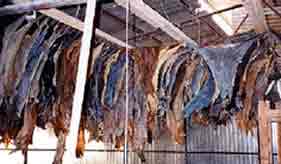 Parchment
Parchment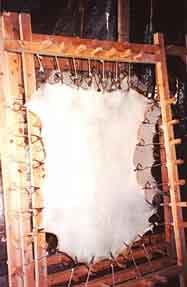 The
hides are soaked in water in preparation for tanning. They are tanned
in limewash for a number of days until the hairs fall off. They are then
hung to dry, resoaked and stretched on a wooden frame and dried. At this
point they are sanded to an even, velvety smooth surface, ready to be
written on.
The
hides are soaked in water in preparation for tanning. They are tanned
in limewash for a number of days until the hairs fall off. They are then
hung to dry, resoaked and stretched on a wooden frame and dried. At this
point they are sanded to an even, velvety smooth surface, ready to be
written on.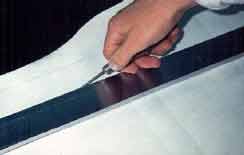
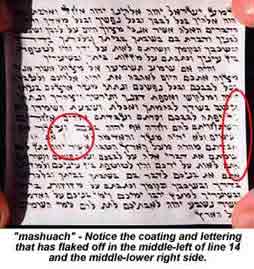 In
addition, there is a halachic issue as to whether such a coating is acceptable.
The sofer must write on parchment, not on paint!
In
addition, there is a halachic issue as to whether such a coating is acceptable.
The sofer must write on parchment, not on paint!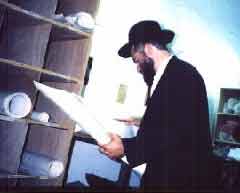 These
laws are very complex and when, how and where must be factored in to every
situation. Please note only a brief introduction to these concepts is
being provided. No halachic opinion can be formed from this introduction.
These
laws are very complex and when, how and where must be factored in to every
situation. Please note only a brief introduction to these concepts is
being provided. No halachic opinion can be formed from this introduction.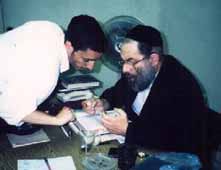 something
in which he is in doubt as to its halachic acceptability etc., in which
case a halachic authority is consulted to render a binding decision.
something
in which he is in doubt as to its halachic acceptability etc., in which
case a halachic authority is consulted to render a binding decision.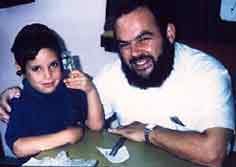 who
knows the letters of the Aleph - Bais but has not yet learned to read,
be asked. Such a child sees nothing other than the form before him and
can judge without any influences. Of course, one must know how to ask
a child so that he remains impartial. A child should not be asked without
first consulting a posek. It is a common misconception that whenever someone
is doubtful as to the kashrus of a letter that a child may be asked. Only
if one who is expert in STaM feels that a letter falls into the realm
of halachic doubt can a child be asked and not doubt due to lack of knowledge.
If a child reads the letter properly it does not necessarily mean that
it is
who
knows the letters of the Aleph - Bais but has not yet learned to read,
be asked. Such a child sees nothing other than the form before him and
can judge without any influences. Of course, one must know how to ask
a child so that he remains impartial. A child should not be asked without
first consulting a posek. It is a common misconception that whenever someone
is doubtful as to the kashrus of a letter that a child may be asked. Only
if one who is expert in STaM feels that a letter falls into the realm
of halachic doubt can a child be asked and not doubt due to lack of knowledge.
If a child reads the letter properly it does not necessarily mean that
it is 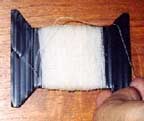 Sinew
string is known as gid. The sinews from the calf area of the cow or bull
is removed and dried. The outer hard shell is removed revealing many threads.
These threads are pulled off and twined together by hand with an adhesive
to form an extremely strong string. They are twined to form a long stretch
of gid and wrapped up as a ball or around a piece of plastic for easy
unraveling.
Sinew
string is known as gid. The sinews from the calf area of the cow or bull
is removed and dried. The outer hard shell is removed revealing many threads.
These threads are pulled off and twined together by hand with an adhesive
to form an extremely strong string. They are twined to form a long stretch
of gid and wrapped up as a ball or around a piece of plastic for easy
unraveling.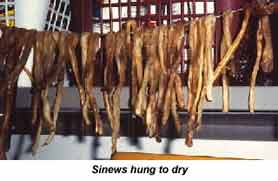 be
done by a Torah observant, adult male or female.
be
done by a Torah observant, adult male or female.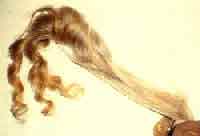 Before
the tefillin are sewn, each of the 4, folded head tefillin parchments
and the single, rolled arm tefillin parchment are wrapped with sa'aros,
hairs from the tail of a cow. They are then tied with a single piece of
plain parchment and again sa'aros are tied around them.
Before
the tefillin are sewn, each of the 4, folded head tefillin parchments
and the single, rolled arm tefillin parchment are wrapped with sa'aros,
hairs from the tail of a cow. They are then tied with a single piece of
plain parchment and again sa'aros are tied around them.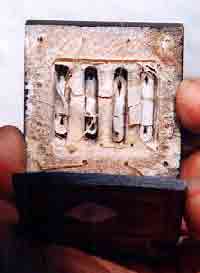
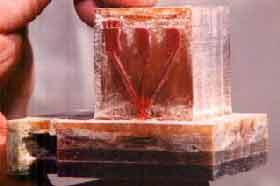
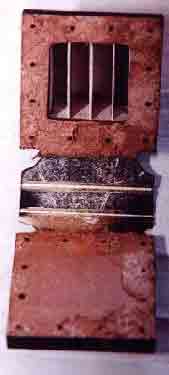
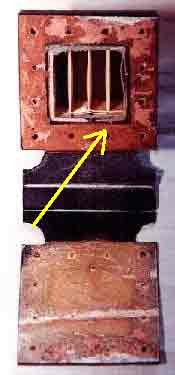
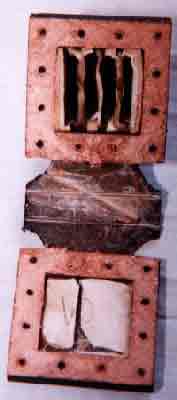
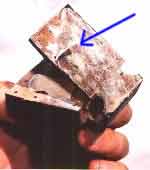
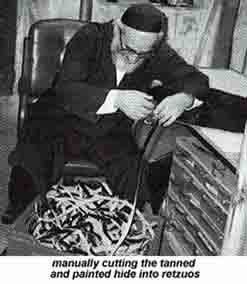
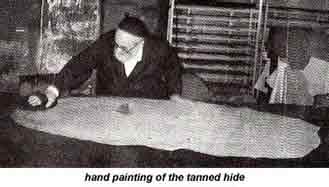 Halachah
requires that the upper surface of the retzuos be completely black. Often
certain spots become worn or frayed and need touching up with special
paint that is available in a paint or marker form. If such paint is not
available many authorities allow for a regular, pitch black marker or
the like to be used. One must say "lishem kedushas tefillin, for
the sake of the sanctification of tefillin, upon touching up his batim
or retzuos. If one has not done so them a sofer or rabbi must be consulted.
Halachah
requires that the upper surface of the retzuos be completely black. Often
certain spots become worn or frayed and need touching up with special
paint that is available in a paint or marker form. If such paint is not
available many authorities allow for a regular, pitch black marker or
the like to be used. One must say "lishem kedushas tefillin, for
the sake of the sanctification of tefillin, upon touching up his batim
or retzuos. If one has not done so them a sofer or rabbi must be consulted.
